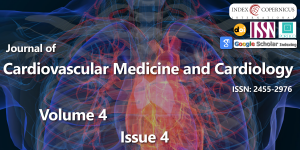A Rare Case of Congenital Rubella Syndrome
Main Article Content
Abstract
Introduction: Congenital rubella syndrome (CRS) is a consequence of rubella infection that can occur when the virus is transmitted in utero during maternal primary infection. It still affects 110,000 children around the world. It has a wide spectrum of presentation which ranges from silent viremia to spontaneous abortions, blindness, deafness, congenital heart disease, and mental retardation.
Case Report: Here, we report a case of CRS in a girl aged 8 years who presented with congenital cataract, severe post ductal coarctation of aorta with patent ductus arteriosus and bilateral sensory neural hearing impairment.
Conclusion: We present a case report of congenital rubella syndrome (CRS); though uncommon nowadays, it is still present in India. The main characteristics of our case report were congenital cataract, severe post ductal coarctation of aorta with patent ductus arteriosus and sensory neural hearing impairment. This case is reported to highlight the importance of vaccination by which rubella infection can be eradicated.
Downloads
Article Details
Copyright (c) 2017 Vishwanath H.

This work is licensed under a Creative Commons Attribution 4.0 International License.
Eilard T, Strannegard O (1974) Rubella reinfection in pregnancy followed by transmission to the fetus. In: J. Infect Dis 129: 594-596. Link: https://goo.gl/aJpy4B
Vijayalakshmi P, Kakkar G, Samprathi A, Banushree R (2002) Ocular Manifestations of Congenital Rubella Syndrome in a Developing Country. Indian J Ophthalmol 50: 307-311. Link: https://goo.gl/cXoPnK
Reef SE, Plotkin S, Cordero JF, Katz M, Cooper L, et al. (2000) Preparing from congenital rubella syndrome elimination: summary of the workshop on congenital rubella syndrome elimination in the United States. Clin Infect Dis 31: 85-95. Link: https://goo.gl/RG9S2j
Jenkins KJ, Correa A, Feinstein JA, Botto L, Britt AE, et al. (2007) Non inherited risk factors and congenital cardiovascular defects: Current knowledge: A scientific statement from the American Heart Association Council on Cardiovascular Disease in the Young: Endorsed by the American Academy of Pediatrics. Circulation 115: 2995-3014. Link: https://goo.gl/FFP5ey
Deka D (2006) Diagnosis of acute rubella infection during pregnancy. J Obstet Gynaecol India 56: 44-46. Link: https://goo.gl/sSBaC7
De Oliveira SA, Camacho LA, de Medeiros Pereira AC, Bulhoes MM, Aguas AF, et al. (2006) Performance of rubella suspect case definition: Implications for surveillance. Rev Saude Publica 40: 450-456. Link: https://goo.gl/eCNSC3
Webster W (1998) Teratogen update: congenital rubella. Teratology 58: 13-23. Link: https://goo.gl/XaAMi2
Miller E, Cradock-Watson JE, Pollock TM (1982) Consequences of confirmed maternal rubella at succesive stages of pregnancy. Lancet 2: 781-784. Link: https://goo.gl/1JfRvQ
Givens KT, Lee DA, Jones T, Ilstrup DM (1993) Congenital rubella syndrome: Ophthalmic manifestations and associated systemic disorders. Br J Ophthalmol 77: 358-363. Link: https://goo.gl/Yhmq3j





